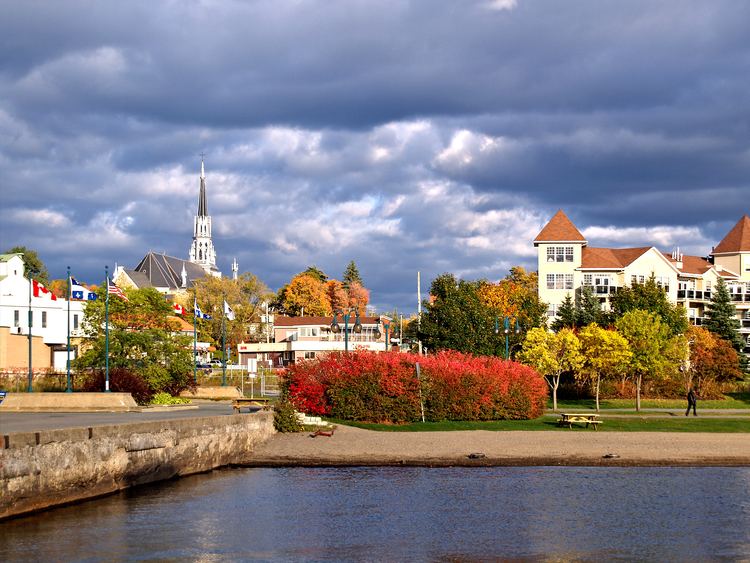RCM Memphrémagog Time zone EST (UTC−5) Population 25,358 (2011) | Constituted October 9, 2002 Postal code(s) J1X Province Québec | |
 | ||
Weather -15°C, Wind W at 2 km/h, 92% Humidity Points of interest Mont‑Orford National Park, Marais de la Rivière aux Ceris, Parc de la Baie‑de‑Magog, Le monde de Tikito, Musée International D'Art Naïf | ||
Magog ( /ˈmeɪɡɔːɡ/; [maˈɡɔɡ]) is a city in southeastern Quebec, Canada, about 120 kilometres (75 mi) east of Montreal at the confluence of Lake Memphremagog—after which the city was named—with the Rivière aux Cerises and the Magog River. It is a major centre and industrial city in the Regional County Municipality of Memphremagog. The city lies in the Eastern Townships tourist region.
Contents
- Map of Magog QC Canada
- Magog quebec via rue principale 2016
- Etymology
- History
- Geography
- Population
- Language
- Economy
- Industry
- Tourism
- References
Map of Magog, QC, Canada
In 2002 the City of Magog was merged with the Township of Magog and the Village of Omerville as part of the municipal reorganization in Quebec.
Magog quebec via rue principale 2016
Etymology
"Memphremagog" comes from the Abenaki word mamhlawbagak, which means "large expanse of water" or "vast lake." "Magog" is believed to be a truncation of the lake's name. However, it could also come from namagok and namagwôttik, which mean "the lake where there is brook trout." Others have theorised that the name has Biblical origins in Gog and Magog, or that it refers to an ancient city by the same name.
History
The Abenaki were the first to inhabit the region and had long visited the Memphremagog and its waterways. The town was founded in 1776, when Loyalists emigrated from nearby Vermont. They called it The Outlet, referring to the flow of water emptying into the Magog River from the lake.
Considered the founder of Magog, Ralph Merry, an American Revolutionary, immigrated to Lower Canada in 1799 and settled in Bolton, to the west of the lake. He bought up all the neighboring lots, including the village of Magog, where he went on to act as its mayor, judge, and developer. In 1821, he built a house there, which is the oldest standing house in the city.
It was formally named Magog in 1855.
At the end of the 19th century and throughout the 20th, the city's economy was dominated by the textile industry, most notably by a cotton mill operated by Dominion Textile. It wasn't until the 1960s and 70s that the city's economy would achieve desperately needed diversification via tourism, services, and the development of the industrial park.
In 2002 the City of Magog was merged with the Township of Magog and the Village of Omerville as part of the municipal reorganization in Quebec.
Geography
Magog is a city in southeastern Quebec, Canada, about 120 kilometres (75 mi) east of Montreal at the confluence of Lake Memphremagog, the Rivière aux Cerises, and the Magog River.
Population
Population trend:
(+) Merged with the Township of Magog and the Village of Omerville on October 9, 2002.
Language
Mother tongue (2011)
Economy
The city is the economic core of the Regional County Municipality of Memphremagog.
Industry
For several generations it was a one-industry (textile) manufacturing town, where Texmade linens were produced. The main plant is still there but has considerably reduced its activities to a few employees mainly making pillows.
Tourism
Magog is in a resort area, with shops and services catering to vacationers and tourists. Tourism is related to the lake and the nearby Mount Orford.
